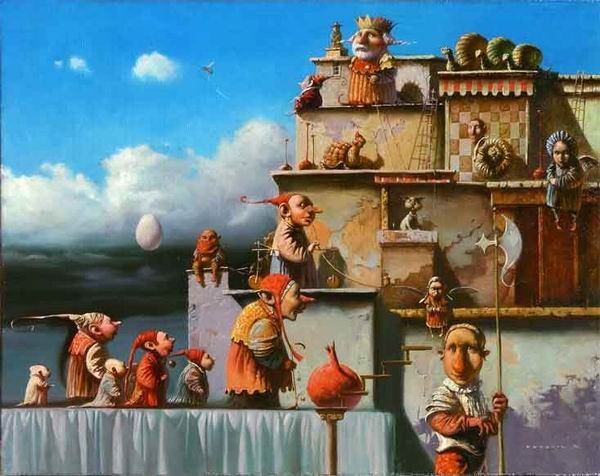
PRINCIPIA SCACCHORUM, Part 8: Bricks in the Wall, or How Chessmen Interact
Why do some teams, despite having capable, powerful, smart members, show collective ineffectiveness and failure?
Well, the same may be true for the men we are leading into chess wars.
Q) How can we improve their collective intelligence for more battles we, as well as our students, can win?
A) By learning and mastering the chess DNA alphabet (wait, say what?)
CHESS GENETICS
In the same way the structure of DNA is founded on four DNA bases: G, C, A and T, your position on the board is based on four piece interactions: A, P, R, I (think of April, a beautiful spring month).
The way the DNA bases are ordered determines the makeup of the genome. Similarly, the way four chess bases (A, P, R, I) are ordered determines the nature of the structure, configuration, organization, arrangement, grouping, positioning, etc. the pieces form on the board when we play chess. They are bricks in the wall.
Here is our CHESS BASICS HIEARARCHY LIST to which three new piece interactoins, as per GM Averbakh, are added:
1) Chessmen
1A) Control/attacking effect
1B) Body effect
1M) Mobility
2) Relationships with Friends and Enemies
2A) Attack (including threat of attack and multiple attack)
P) Protection
R) Restriction
I) Interposition (block, cover, pin)
2K) Kill (capture)
3) Collective direction (goals)
FOUR PIECE RELATIONSHIPS
Attack (A)
This is the generic piece contact, the Alpha and Omega of chess. Geometrically speaking, it is a line segment defined with two endpoints: the attacking piece's location and, either an empty square, or an enemy piece, that happen to be in the attacker's line of force.
Functionally, the space around an attacker, as well as other pieces in it, experience an effect (force) due to the presence of the attacker (a physicist may say, the force space/field is warped).
Chess autors may also use terms like control, pressure, offensive contact, etc. for the attacking contact.
Protection (P)
The contact established between a player's pieces for mutual defense, or safekeeing. The term is a little bit of a misnomer (namely, I have noticed that my students - when I use the term protection before expanding on what it really means - get under a false impression that the "protected" piece is absolutely safe, even when attacked by a lower value enemy).
In reality, the defensive contact is not protecting the friend from capturing by an attacker. It keeps the friend safe only if the attacker's relative value is greater than the attacked, "protected" unit. In other words, this mechanism allows the protecting friend to recapture, thus keeping the material balance. For axample, Re1 is attacking Pe5, while black Re8 is guarding it. If White takes Re1xe5, an attacking conact is established between Re8 and Re5. Thus, Re8xe5 follows.
This logic only applies in "normal" chess times. When a combination is about to release, the opponent may sacrifice one of his attackers for a lesser value enemy unit. This is typically done to direct the movement of the protector, which would consequently lose control over some important squares/lines, which in turn achieves the attacker's power superiority in the critical sector of battlefield where the attack is developing.
Restriction (R)
There are two kinds of restricting the movement of pieces.
a) By use of force. The control effect chess pieces produce (1a) limits freedom of movement of enemy pieces. For example, Re1 is controlling the e-file. Black's Qd8 is restricted to move to e7/e8, unless there is a reason for sacrifice.
We see that restriction is just a consequence of an enemy piece controlling a square/line which puts our pieces to danger of capture if they move there. It is applicable to enemy pieces only. Again, this also applies only in "normal" times.
b) By physical presence. This is nothing more than our previously defined body effect (1b). It applies to both friendly and enemy pieces. For example, Re8 is attacking (checking) Kh8. The black h7 and g7 pawns are restricting their King's movement to escape. So mate.
Interposition/block/cover/pin/ (I)
The three contacts discussed so far have only two pieces (or a piece and square) involved. Interposition features three (rarely two) pieces lining up: an attacker, a blocking piece, and an actual target (w: Rd1; b: Pd5, Qd8). Not only a piece can be targeted (like Qd8 above), a target could also be a square, e.g. in case black d5-pawn takes a white enemy on c4/e4, there may be a possible mate along the back rank, Rd1-d8).
Pin is not an elementary contact strictly speaking. In reality, it is just a double attack. Multiple attack is any combination of attack and threat of attack (or coming-next-move, one-move-away, indirect, concealed attack). In the above example, Rd1 is directly attacking Pd5, while Qd8 is under threat of attack from Rd1, in case Pd5 takes on c4/e4.
* * *
For your students to beef up the game, get them learn and master this chess alphabet asap till it becomes second nature (using a new, modern, redesigned teaching method).
That would signify the point out of Level One, the gate that separates Chess Kindergarten from the rich grassy Meadowlands of Chess where everybody can enjoy forever!
Art by Mariano Degano, Italy
Tags: chess education, chess teaching, chess basics, chess fundamentals, piece interaction, piece contacts, piece relationships
